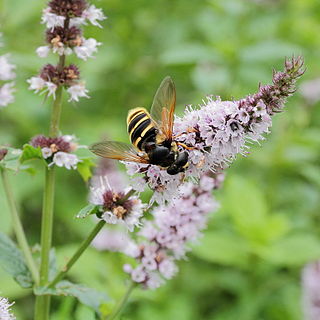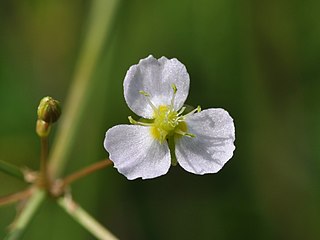
Mentha, also known as mint, is a genus of flowering plants in the mint family, Lamiaceae. It is estimated that 13 to 24 species exist, but the exact distinction between species is unclear. Hybridization occurs naturally where some species' ranges overlap. Many hybrids and cultivars are known.

Gleditsia is a genus of trees in the family Fabaceae, subfamily Caesalpinioideae, native to the Americas and Asia. The Latin name commemorates Johann Gottlieb Gleditsch, director of the Berlin Botanical Garden, who died in 1786.

Mentha aquatica is a perennial flowering plant in the mint family, Lamiaceae. It grows in moist places and is native to much of Europe, northwest Africa and southwest Asia.

Alisma plantago-aquatica, also known as European water-plantain, common water-plantain or mad-dog weed, is a perennial flowering aquatic plant widespread across most of Europe and Asia, and apparently spread elsewhere in both the Old and New World.

Phalaris is a genus of flowering plants in the grass family. Species of Phalaris are distributed across all continents except Antarctica. They can be found in a broad range of habitats from below sea level to thousands of feet above sea level and from wet marshy areas to dry places. P. arundinacea and P. aquatica are sometimes invasive species in wetlands.

Ipomoea aquatica, widely known as water spinach, is a semi-aquatic, tropical plant grown as a vegetable for its tender shoots. I. aquatica is generally believed to have been first domesticated in Southeast Asia. It is widely cultivated in Southeast Asia, East Asia, and South Asia. It grows abundantly near waterways and requires little to no care.

Pachira aquatica is a tropical wetland tree in the mallow family Malvaceae, native to Central and South America where it grows in swamps. It is known by its common names Malabar chestnut, French peanut, Guiana chestnut, Provision tree, Saba nut, Monguba (Brazil), Pumpo (Guatemala) and Jelinjoche and is commercially sold under the names Money tree and Money plant. This tree is sometimes sold with a braided trunk and is commonly grown as a houseplant, although more commonly what is sold as a "Pachira aquatica" houseplant is in fact a similar species, P. glabra.

Nyssa aquatica, commonly called the water tupelo, cottongum, wild olive, large tupelo, tupelo-gum, or water-gum, is a large, long-lived tree in the tupelo genus (Nyssa) that grows in swamps and floodplains in the Southeastern United States.

Crassula aquatica is a succulent plant known by the common names water pygmyweed, common pygmyweed and just pigmyweed. It is an annual plant of salt marshes, vernal pools, wetlands, and other fresh to brackish water bodies. It is at least partially aquatic, living in areas which are submersed much of the time. It also lives along muddy banks and in tidally-active areas of estuaries.

Limnophila is a genus of flowering plants in the family Plantaginaceae. It is distributed in tropical and subtropical regions of Africa, Asia, Australia, and the Pacific Islands. Species are known commonly as marshweeds.

Planera aquatica, the planertree or water elm, is a species of flowering plant. Found in the southeastern United States, it is a small deciduous tree 10–15 m tall, closely related to the elms but with a softly, prickly nut 10–15 mm diameter, instead of a winged seed. It grows, as the name suggests, on wet sites. Despite its common English name, this species is not a true elm, although it is a close relative of the elms. It is also subject to Dutch elm disease, a disease which affects only members of the Ulmaceae. It is native to most of the southeast United States. It is hardy down to Zone 7.

Limosella aquatica is a widespread species of flowering plant in the figwort family known by the common name water mudwort. It is native to much of the temperate world, where it grows in many types of wet habitat. It is semiaquatic, growing in moist land habitat such as meadows, in mud and wet sand next to water, and partly submersed or floating in the water. It is a fleshy annual herb forming low tufts in muddy substrate. The leaf is made up of a petiole up to 30 centimetres (12 in) long but usually quite a bit shorter, tipped with a flat spoon-shaped blade up to 3 cm (1.2 in) long. The inflorescence is an erect stalk bearing one tiny white to pink- or blue-tinted flower about 2 millimetres (0.08 in) wide. The fruit is a capsule up to 5 mm (0.20 in) wide containing many tiny seeds.

Veronica anagallis-aquatica is a species of flowering plant in the family Plantaginaceae known by the common names water speedwell, blue water-speedwell,brook pimpernel.

Hellenia is a genus of plants in the Costaceae described as a genus with this name in 1791. It is native to Southeast Asia, southern China, the Indian Subcontinent, New Guinea, and Queensland. The type species was "H. grandiflora" Retz., which is a synonym of Hellenia speciosa.

Oenanthe aquatica, fine-leaved water-dropwort, is an aquatic flowering plant in the carrot family. It is widely distributed from the Atlantic coast of Europe to central Asia.

Pachira glabra is a tropical wetland tree in the mallow family, Malvaceae, native to eastern Brazil, where it grows along waterways. It is generally known by the nonscientific names Guinea peanut, French peanut, Saba nut, money tree, and lucky tree. It shares many of these common names with the similar P. aquatica.

Catabrosa aquatica, called brookgrass, water whorl-grass, water whirlgrass and water hairgrass, is a widespread species of semi-aquatic grass in the genus Catabrosa, native to most of the non-tropical northern hemisphere, and to southern Chile and Argentina. As its scientific and common names suggest, it prefers to grow in wet areas, such as meadows, stream banks and lake shores.

Nepsera is a monotypic genus of flowering plants belonging to the family Melastomataceae. The only species is Nepsera aquatica.
Eragrostis aquatica is a species of grass, native to west Honshu island, Japan. It grows on the edges of wet areas, and has also been recorded from South Korea.

Rorippa aquatica, the lakecress or lake cress, is a species of freshwater aquatic flowering plant in the family Brassicaceae. It is found in eastern and central North America, generally in the Great Lakes and Mississippi watersheds. A submerged perennial, it has emergent flowering branches. It is typically found in slow-moving water, such as oxbow lakes. It is used as a foreground aquarium plant, as it is undemanding and very slow-growing.


















